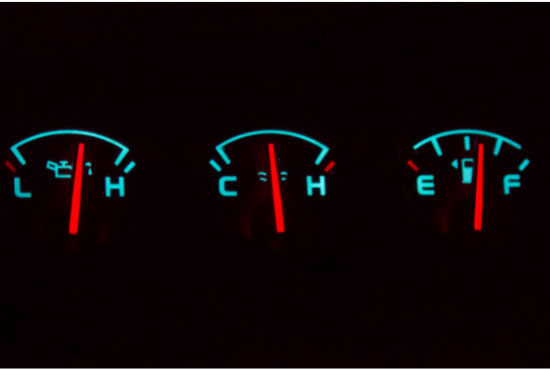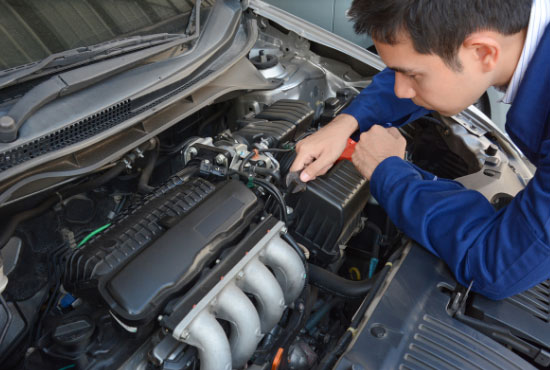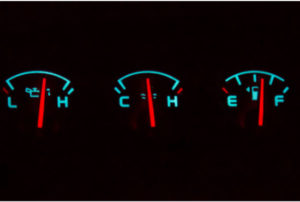There are a lot of people that are never concerned about the temperature their vehicle is running at until something goes wrong and their vehicle is no longer running. I often get asked what temperature is ideal for a Jeep Wrangler to run at.
A 4.0 engine should never be run at a temperature greater than 230, but will frequently run between 206 and 220.
What Temperature Should A Jeep Wrangler Run At
The ideal temperature for your Jeep is 210. One of the important issues with engine temperature is the vehicle should reach the normal temp range pretty quickly and then should sustain that range without drastically dropping or rising.
If My Engine Temperature Is High What Does That Mean?

If the temperature gauge in your vehicle is showing an increase in temp or a high temp of over 220 degrees then you need to find out what is going wrong. Some of the main reasons why this happens are:
- A leak in a radiator hose
- A radiator that has malfunctioned
- A leak in the radiator itself
- A thermostat that has stuck or needs to be replaced
- A water pump that has quit working
- Malfunction of the radiator fan
- The vehicle is under undue stress
- The oil level is too low
- The heater core is stopped up
If your vehicle is running at too high of a temp you should pull over as soon as possible and find out what the problem is. Running a vehicle too hot for an extended period of time can cause severe engine damage.
Tips About What Not to Do to an Overheated Vehicle

- Never pour cold water into a radiator that is hot. The cold water could cause your engine block to crack.
- Do not immediately open the hood of your vehicle. Let the car cool down to avoid a steam burn.
- Do not try to take the radiator cap off the radiator.
- Do NOT just keep driving.
What to do if your Jeep runs too hot
You cannot always prevent your vehicle from running hot. Things break and accidents happen so at some time you more than likely will experience an overheated Jeep. The first thing you need to do is remain calm. Overheating does not always mean the vehicle needs major repairs. Take a deep breath and follow the advice below.
- Find a safe place to pull over as soon as you can. If you are stuck in traffic try shifting the vehicle into park or neutral. Gently rev the engine by pressing on the accelerator. This should make the water from the radiator flow more quickly through the engine.
- If you are in dense traffic avoid stopping and starting. Slow down as slowly as possible and look for the first safe place to pull over.
- Turn the air conditioner off as soon as you notice the temperature rising. Crank up the heater in the car and this may transfer heat enough to help prevent severe damage.
- When you get stopped kill the engine. Remember that if the car is too hot the engine may not restart until the problem is addressed.
- Allow the engine to cool some before you open the hood.
- Check the coolant reservoir to see if it is full.
- After the engine cools down you can add coolant to the reservoir.
- Look under the car for signs of a leak.
- Call a tow truck if you cannot find the problem
Prepare For a Leak
As mentioned earlier, if you drive regularly then there is going to come a time when your vehicle is going to run too hot. It is best to be prepared in advance for this situation.
Keep a gallon of the coolant you use in your vehicle in the trunk of the vehicle. If you do get a leaky hose or a leak in a radiator you may be able to add coolant and get the vehicle to a shop or somewhere that the leak can be addressed.
Check your fluid and coolant levels often. If you notice coolant levels that are low on a regular basis, or suddenly see that you need to add to your reservoir, then get the vehicle checked out for leaks or parts failure.
Check your thermostat from time to time to make sure that it is functioning properly.
- Remove the radiator cap
- Crank the engine of the vehicle
- Look into the radiator to see if you can see the liquid inside it flowing. This flow will not start to happen for a few minutes because the car must reach temperature before the flow begins.
- If you see a flow before the engine reaches operating temperature then your thermostat may be stuck in an open position.
- If you do not see the liquid flow even after the car reaches the right temperature your thermostat is stuck in a closed position.
Replacing the thermostat is not very expensive and most car owners can do this without going to a mechanic.
Related Article:
1. Is Dex-Cool Best for My Jeep?
2. Do Jeep Grill Inserts Cause Overheating
Frequently Asked Questions
How Hot Should My Jeep Wrangler Run?
About 210 degrees is perfect for most Jeep Wranglers.
Are 230 Degrees Too Hot for An Engine?
Yes, if your engine reaches 230 you need to find out what is causing it to overheat.
Can I Just Add Water to The Radiator to Cool The Engine Down?
Wait until the engine has cooled before you attempt to add any liquid. Coolant is best but if water is all you have then you can add water and drive to the nearest auto shop for service.
Final Thoughts
Most of the time when your car engine overheats it is due to something minor like a leak in a hose or a stuck thermostat. These are not expensive things to repair. Occasionally the radiator will develop a leak and you might be able to fix it with some additive like Stop Leak. You must pay attention to car temperature because an overheated engine can crack and head and require extensive repair.

